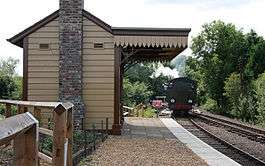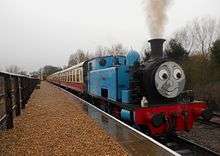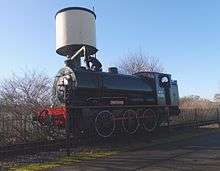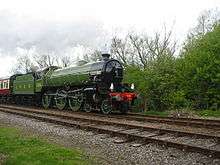Nene Valley Railway
| Nene Valley Railway | |
|---|---|
|
The Polish 0-8-0T Class Slask No Tkp 5485 departs Wansford with a train for Yarwell | |
| Locale | England |
| Terminus | Peterborough |
| Commercial operations | |
| Name | London and North Western Railway |
| Built by | London and Birmingham Railway |
| Original gauge | 4 ft 8 1⁄2 in (1,435 mm) standard gauge |
| Preserved operations | |
| Operated by | Nene Valley Railway |
| Stations | 5 |
| Length | 7 1⁄2 miles (12.1 km) |
| Preserved gauge | 4 ft 8 1⁄2 in (1,435 mm) standard gauge |
| Commercial history | |
| Opened | 1847 |
| Closed to passengers | 1966 |
| Closed | 1972 |
| Preservation history | |
| 1974 | Line purchased by Peterborough Development Corporation |
| 1977 | NVR reopened |
| 1983 | Orton Mere (station building) opened |
| 1986 |
NVR Extended Peterborough (Nene Valley) opened |
| 1995 | Wansford (current station building) opened |
| 2007 | Yarwell Junction (current terminus) reopened |
| 2008 | Yarwell Junction Station Building opens officially |
| Headquarters | Wansford |
| Nene Valley Railway | ||||||||||||||||||||||||||||||||||||||||||||||||||||||||||||||||||||||||||||||||||||||||||||||||||||||||
|---|---|---|---|---|---|---|---|---|---|---|---|---|---|---|---|---|---|---|---|---|---|---|---|---|---|---|---|---|---|---|---|---|---|---|---|---|---|---|---|---|---|---|---|---|---|---|---|---|---|---|---|---|---|---|---|---|---|---|---|---|---|---|---|---|---|---|---|---|---|---|---|---|---|---|---|---|---|---|---|---|---|---|---|---|---|---|---|---|---|---|---|---|---|---|---|---|---|---|---|---|---|---|---|---|
| ||||||||||||||||||||||||||||||||||||||||||||||||||||||||||||||||||||||||||||||||||||||||||||||||||||||||
The Nene Valley Railway (NVR) is a preserved railway in Cambridgeshire, England, running between Peterborough Nene Valley and Yarwell Junction. The line is 7 1⁄2 miles (12.1 km) in length. There are stations at each terminus, and three stops en route: Orton Mere, Ferry Meadows and Wansford.
History
Origins
In 1845, the London and Birmingham Railway (L&BR) company was given parliamentary assent to construct a line from Blisworth in Northamptonshire to Peterborough. Completed in 1847, it was Peterborough's first railway line. It terminated at Peterborough, later 'Peterborough East' station. The sheds and one platform face of this disused station are still clearly visible next to the former Matalan store on East Station Road, off London Road.
The line was of little significance until the late 19th century, when the London & North Western Railway (L&NWR), which had absorbed the L&BR, constructed a line via Nassington and King's Cliffe to Seaton, below Welland Viaduct. This turned Wansford, previously an unimportant village station, into a major junction. Its importance increased a few years later when the Great Northern Railway constructed another line via Sutton, Southorpe and Barnack to Stamford, on the Midland Railway line. In 1884 the line received a royal visit when the royal family travelled from Peterborough to Barnwell, some 13 miles (21 km) beyond Wansford, to visit Barnwell Manor, home of the then Duke of Gloucester. The station building is now preserved at Wansford station on the NVR, and is known as the Barnwell building.
Between 1900 and the 1960s, the line formed an important connection from Norwich, Cambridge and eastern England to Northampton and the Midlands. The line was generally acknowledged to be a secondary main line and frequently saw large engines such as Black 5s and B1s. However, the NVR was one of the last passenger line closures of the Dr Beeching era, services to Northampton and Rugby having ceased in 1964 and 1966 respectively. It remained open until 1972 for freight traffic only.
Society formed

In 1968, the Rev. Richard Paten had bought BR Standard Class 5 4-6-0 locomotive, number 73050, for its scrap value of £3,000. His intention had been to exhibit it outside Peterborough Technology College as a monument to Peterborough's railway history. However, the locomotive was found to be in good working order, and there was much opposition to the idea of the engine being "stuffed", and it was decided to restore it to full working order.
On 28 March 1969, the Peterborough Branch of the East Anglian Locomotive Society was formed, with the intention of purchasing and restoring the BR Pacific locomotive, number BR Standard Class 7 70000 Britannia. By 1970, the branch was strong enough to operate independently as the Peterborough Locomotive Society (PLS). In 1971, 73050 was moved to the British Sugar Corporation's sidings at Fletton, where it was joined by Hunslet 0-6-0 locomotive 'Jack's Green'. Later that year, the PLS held a meeting at which the group's name was changed to 'Peterborough Railway Society' and the idea of the Nene Valley Railway was formally launched.
Purchase of line and locomotives

In 1974, the Peterborough Development Corporation (PDC) bought the Nene Valley line between Longville and Yarwell Junctions and it began leasing it to the PRS to operate the railway – a major milestone in the society's history.
When the PRS acquired the line, the intention was to work the line with British locomotives and stock. However, enthusiasts from other railways and preservation societies had already acquired almost all of the serviceable ex-BR locomotives – all that was left was a collection of rusting hulks. Apart from 73050, the society's locomotives were mostly small, industrial shunting engines and therefore not suitable for the 11-mile (17.7 km) round trip. Ex-BR rolling stock was also in very short supply following the disposal of most pre-nationalisation (pre-1948) stock. The PDC, having paid out a considerable sum of money for the line, was anxious that trains should start running as soon as possible – certainly before the opening of the new Nene Park in 1978. However, with the PRC's lack of stock and locomotives this looked highly improbable.
In 1973, PRS member Richard Hurlock had approached the society for a home for his ex-Swedish railways class S1 2-6-4T oil-fired locomotive, number 1928. Because the engine was higher and wider than British stock, it was to be a static exhibition only. During 1974, it was realised that the use of foreign stock and engines could answer the NVR's aspirations. After a feasibility study was carried out, it was discovered that only one bridge would have to be demolished to allow the running to continental loading gauge. Some reductions would also have to be made to the width of the platforms. In 1973, BR gave PRS permission to use Wansford signal box and, in September of that year, the first items of stock arrived at the PRS depot.
Operation
Before the stock could be moved from the BSC depot to Wansford, the missing 400 yards (366 m) of the Fletton Loop had to be rebuilt, allowing access to the Nene Valley line. The track was completed in March 1974 and the stock moved to Wansford in time for the Easter weekend, when the new 'Wansford Steam Centre' opened for the first time. Between 1974 and 1977, the line was upgraded to passenger-carrying standard and the first passenger train ran on 1 June 1977, hauled by the 'Nord 3.628' – a French 4-6-0 locomotive and 'SJ 1178' – another Swedish tank engine, pulling a set of ex-BR electrical multiple unit coaches owned by the Southern Electric Group.
Extension to Peterborough
In the early 1980s, the NVR decided to extend its running line, which then terminated at Orton Mere station, along the route of the original Nene Valley Line to a new station west of the East Coast Main Line, adjacent to the new Railworld Museum. Peterborough Nene Valley opened, for the first time, on the Late Spring Bank Holiday weekend of 26 May 1986. This extended the NVR to its current length, 7 1⁄2 miles (12.1 km).
Proposed developments
Crescent Link/Peterborough Parkway
Since 1999, there has been talk of the 'crescent link' project promoted by 'Railworld' – a scheme to allow the NVR to run trains through the westernmost end of the Nene Park, across the river Nene into Peterborough mainline station to connect directly with Virgin Trains, Greater Anglia, East Midland Trains, Arriva Cross Country and Great Northern services.
This might be done in connection with the proposed redevelopment and modernisation of Peterborough station. However, no fixed date has been set for this development.
The Crescent Link could include a reconstruction of the old Peterborough East station site as "Peterborough Parkway". This would be at least 1 mile (1.6 km) east of Peterborough Nene Valley station.
Oundle/Elton
The society aspires to extend the line westward via Elton towards Oundle crossing the Cambs/Northants border in the future.
An attempt was made to extend the Nene Valley Railway to both Elton railway station and Oundle back in the 1990s, but was abandoned for financial reasons. The station site is still intact but the buildings have been demolished since closure (with whole/entire land still free from redevelopment to a new site at Oundle (as the original station site at Oundle itself is now in private residence, meaning a new site might be required).
Stations

Yarwell Junction
Yarwell Junction is the former junction between the lines to Northampton and Market Harborough. It is the current terminus of the NVR's operating line. In April 2006 the track was realigned, allowing a platform to be built at Yarwell Junction, which opened at Easter 2007 (there was never previously a station on the site). The new station is linked by footpaths to Nassington and the mill village of Yarwell, but there is no vehicular access. Yarwell Junction is about 1 mile (1.6 km) west of Wansford station, at the other end of Yarwell Tunnel.
Wansford
Wansford is the headquarters of the railway and most of the facilities are based here. The current station building was opened in 1995 and contains a ticket office, shop, cafe and toilets. The locomotive sheds are located at this station. Also at the station there is a picnic area and children's playground. The station was formerly the junction for a branch to Stamford, which diverged to the north just east of the river bridge at Wansford. The original Wansford station is located on platform three and was built in 1844–1845 in Jacobean style for the opening of the railway. This building was purchased by the railway in 2015.
Castor
Castor is a disused station between Wansford and Ferry Meadows. It closed in the 1960s and despite the NVR (which runs through it) reopening, the station remains closed as of March 2013.
Ferry Meadows
Ferry Meadows is located near the site of Orton Waterville station and provides access to the nearby country park. The current building was moved brick by brick from the old goods yard at Fletton Junction on the East Coast Main Line; it replaced a portable building desperately in need of repair. NVR is now adding a canopy which is due for completion in 2016. The station building was offered to the NVR for £1 plus transportation costs. The Park is open throughout the year, but most facilities such as the miniature railway and pedaloes only run from Easter to the end of October. The station is also the site of the new Night Mail Museum, with construction well under way.[1]
Orton Mere
Orton Mere is a two platform station with a station building built in 1983 and a signal box. Until 1986 this was the terminus of the line. Most trains depart from platform 1. Just outside the station towards Peterborough is the Fletton Loop which links the NVR to the mainline. The signal box controls the passing loop and had to be adapted from one lever to three.
This station provides access to the eastern end of the Nene Park.
Longville Junction
Longville (or Longueville) Junction is about 1 mile (1.6 km) from Peterborough (Nene Valley) and links to the nearby East Coast Main Line. As of March 2013, there is no platform here, as Orton Mere station is only a few hundred yards close by.
Peterborough (Nene Valley)
Peterborough Nene Valley (aka Peterborough West), is the current end of the line. Here there is a platform, a bay platform and a station building housing a ticket office, a small souvenir shop and toilets. It is a 10-minute walk from here to Peterborough City Centre. Railworld is next door to the station with a wide variety of rolling stock on display.
Locomotives
The Nene Valley Railway has a full-scale "replica" of Thomas the Tank Engine working a passenger and freight service on 'Thomas' events; it was the first railway in the world to possess one. The Nene Valley Railway considers its Thomas to be the "official" Thomas the Tank Engine, because it was named by Thomas' creator, the Rev. W. Awdry, in 1971. The replica engine runs at various special events, weekends and bank holidays; however, the Nene Valley Railway does not host official 'Day out with Thomas' events as many railways do.
Operational steam locomotives

Residents
- Hudswell Clarke 0-6-0T No. 1800 'Thomas'. Built in 1947. Restricted to around Wansford Yard and hauling Wansford – Yarwell Junction shuttles only, apart from an annual trip to Peterborough. Returned to steam in June 2016 following a two and a half year overhaul.
- BR (Southern) Bullied 4-6-2, unrebuilt Battle of Britain class No. 34081 '92 Squadron'. Built in 1948. Arrived on 20 May 2010 at Wansford from the North Norfolk Railway, having left that line in 2003. The loco returned to steam in January 2017 following a seven year overhaul.
Visitors

- Hunslet Austerity 0-6-0ST (W/No.2857) No. WD75008 'Swiftsure'. On loan from the East Lancashire Railway.
Steam locomotives undergoing overhaul or restoration
- Danish 0-6-0T Class F No. 656 'Tinkerbell' (unofficial name). Built in 1949. Undergoing a major restoration.
- Hunslet 0-6-0ST No. 1589 'Newstead'. Built in 1924. The engine arrived on the railway in April 2016 following its rediscovery after spending over 20 years in a privately owned shed.[2] Its overhaul has now begun and its boiler has been lifted.
- Polish 0-8-0T Class Śląsk/TKp No. 5485. Built in 1959. Withdrawn Summer 2012 for overhaul. The engine has been moved to the Flour Mill works for this overhaul and is expected to return to the railway when this is completed.
- BR Standard Class 5 4-6-0 No. 73050 'City of Peterborough'. Built in 1954. Withdrawn September 2014 for overhaul which commenced in 2017.
Stored steam locomotives
- Hunslet Austerity 0-6-0ST 75006. Built in 1943. Awaiting overhaul after being withdrawn in 2004.
- German 2-6-2T Class 64 No. 64.305. Built in 1936. Now stored awaiting overhaul. Original intentions had been to start work once 1178 was completed. However, due to the potential costs of asbestos removal this now looks unlikely.
- Swedish B Class 4-6-0 No. 101. Built in 1944. On static display after being withdrawn from service in 2005. Disguised as a German D class locomotive, No. 101 was used in the James Bond film Octopussy.[3]
- Hudswell Clarke 0-6-0ST No. 1539 'Derek Crouch'. Built in 1924. Originally on display in Wansford Yard, this locomotive has now been moved to the siding between the 1995-built station building and turntable following a cosmetic restoration.
- Hunslet 0-6-0ST No. 1953 'Jacks Green'. Built in 1939. Has currently been moved into the shed for cosmetic restoration to begin, including a repaint into its original industrial livery.
- Swedish 2-6-2T Class S No. 1178. Built in 1914. Awaiting major restoration.
- Cockerill 0-4-0WT Tram Engine No. 1626 'Toby'. Built in 1890. Project ceased after death of Rev. W. Awdry.
Operational diesel locomotives
- BR Class 31 A1A-A1A No. 31271 (New style RailFreight livery)
- BR Class 14 0-6-0 No. D9520
- BR Class 14 0-6-0 No. 14029 (D9529)
- Sentinel 4 wheeled No. 10202 'Barabel'. In regular use in the yard.
- Sentinel 0-6-0 No. DL83. In service. A regular shunter in the yard.
- SJ Class Y7 Diesel Railcar 1212 B-2 'Helga'
- Plasser & Theurer TASC 45 track maintenance vehicle. In service. Used for track maintenance by the civil engineering department.
Diesel locomotives undergoing overhaul or restoration
- BR Class 14 0-6-0 No. D9523. Undergoing maintenance.
- Hibberd 0-4-0 No. 2896 'Frank'. Undergoing a major restoration.
- Yorkshire Engine Company No. D2654. Undergoing repairs.
Stored diesel locomotives
- Ruston & Hornsby 0-4-0 No. 304469. Stored awaiting major restoration.
- English Electric 0-4-0 No. 1123. Stored awaiting overhaul.
Locos that have left the line

Steam Locomotives
- LMS Fowler Class 4F 0-6-0 No. 44422. Built in 1927. Based on the line courtesy of the 44422 Locomotive Fund from 2010-2013. After failing a boiler exam in July 2013 it was decided to withdraw the engine for overhaul early. Initially reallocated to Peak Rail, it is now at the West Somerset Railway following its overhaul at Crewe Heritage Centre.
- German/Polish Kriegslok 2-10-0 Class 52/Ty2 No. 52.7173/Ty2-7173. Built in 1943. Withdrawn from service in 2001. This locomotive has been sold to Patrimoine Ferroviaire et Tourisme, a museum collection in Belgium and has left Wansford MPD.[4] Since 2013, it has been cosmetically restored as Belgian class 26.102
- French de Glehn compound 4-6-0 Nord 3.628. Has left the railway and went to Longueville, Seine-et-Marne, France to be restored to work on the mainline. Is being cosmetically restored.
- LNER 4-6-0 Class B1 No. 1306 'Mayflower'. Built in 1948. Based on the line from 1991–2006. Initially sold to the Battlefield Line, Shackerstone, it is now based at the North Norfolk Railway and is mainline registered.
- Avonside 0-6-0ST Class B4 No. 1945. Built in 1926. Elsecar Railway, Barnsley.
- BR 4-6-2 Class 7MT No. 70000 'Britannia'. Built in 1951. Based on the line from 1980–2000. Moved to Crewe Heritage Centre and now based at Southall.
- German 0-6-0T Class 80 No. 80.014 Built in 1928. 1981–1997 has been optically refurbished and is in the South German Railway Museum, Heilbronn (Süddeutsches Eisenbahnmuseum Heilbronn).
- Danish 2-6-4T Class S No. 740 1980–1995 Denmark
- LMS 4-6-0 Class 5MT No 5231 Built in 1937. Based on the line from 1988–1993. Moved to the Watercress Line and now based at Carnforth MPD.
- Barclay 0-4-0ST (2248)/90432 1972–1991 East Kent Light Railway, Shepherdswell
- Swedish 2-6-4T Class S1 No. 1928 1973–1989 Tunbridge Wells (Now in private hands)
- Peckett 0-6-0ST No. 2000 1977–1984 Built in 1942. Barrow Hill
- Avonside 0-6-0ST No. 1917 'Pitsford' Built in 1923. 1973–1983 Elsecar Steam Railway
- Hawthorn Leslie 0-6-0ST No. 3837 'Corby No. 16' Built in 1934. 1974–1981 Leatherhead (now Lavender Line with Hawthorn Leslie 3837 Preservation Society)
- Hudswell Clarke 0-6-0ST No. 1604 1975–1981 Built in 1928. Wetheringsett
- Avonside 0-4-0ST No. 1908 'Fred' Built in 1925. 1976–1981 Dendermonde, Belgium
- Hudswell Clarke 0-6-0T No. 1844 1976–1980 Scrapped (spares for 1800 'Thomas') Built in 1947.
- Southern Railway 4-6-0 Class S15 No. 841 'Greene King' built in 1936. 1977–1978 Grosmont
- Hunslet Austerity 0-6-0ST (W/No.3844) No. 22 from Appleby Frodingham Railway. Based on the line from 2011-2016.
Diesel Locomotives
- D306 'Atlantic Conveyor', BR Class 40. Departed May 2011 to Washwood Heath. The locomotive was purchased by the Class 40 Preservation Society in November 2015 and is to be based at the East Lancashire Railway.
- D9516 BR Class 14. Sold following death of owner, April 2011 To Wensleydale
- D9523 BR Class 14. Sold following death of owner, April 2011 to Derwent
- Sentinel 4 wheeled No. 11. May 2010 to Washwood Heath
- BR Class 47 Co–Co No. 1971/47270 'Swift'. 'BREL', Mainline use. Departed 30 July 2009.
- BR Class 56 Co–Co No. 56114. Hanson Traction Ltd. Departed 14 August 2009
- BR Class 31 A1A-A1A No 31190. Hanson Traction Ltd.Departed 30 July 2009
- BR Class 50 No. 50008 'Thunderer'. Hanson Traction Ltd. Departed 9 October 2009
- BR Class 117 3 car DMU Nos. 51347 / 59508 / 51401, 1998–2009. Destination: Gwili Railway, Wales
- BR Class 56 Co–Co No. 56057 "British Fuels" 2004–2007 Main Line use
- 2894 "Percy" Hibberd 0-4-0 1972–2006 Norfolk
- 31108 BR Class 31 A1A-A1A 200?–2005 Midland Railway, Butterley
- D9529 "14029" BR Class 14 0-6-0 DH 1988–2000 Stratrail (Kent & East Sussex Rly) Returned in 2012.
- D2112 BR Class 03 0-6-0 DM 1991–1998 Boston Docks
- 08704 BR Class 08 0-6-0 DE 1993–1997 Boston Docks
- 319294 Ruston & Homsby DS165 0-6-0DM 1991–1996 Northampton & Lamport Railway
- 4220033 John Fowler 0-4-0DH 1991–1996 Northampton Ironstone Railway Trust, Hunsbury Hill
- D7594 BR Class 25 Bo-Bo DE 1992–1994 K&ESR
- 804 Alco S-1 1986–1991 Railworld, Peterborough (adjacent to Peterborough Nene Valley station)
- 8368 "Horsa" RSH 262 hp 0-4-0 DH 1980–1991 East Dereham
- 294268 Ruston & Homsby DS48 4wDM 1975–1991 East Kent Light Railway, Shepherdswell
- 321734 Ruston & Homsby DS88 4wDM 1979–1991 East Kent Light Railway, Shepherdswell
- D2089 BR Class 03 0-6-0 DM 1991 Mangapps Railway Museum, Bumham-on-Crouch
- 1212 SJ Class Y7 Diesel Rallcar 1984–1989 Fleggburgh then Tweddle Animal Farm *** Returned to NVR 22 November 2011
- D9016 "Gordon Highlander" BR Class 55 Co–Co DE 1984–1989 East Lancs
- D9000 "Royal Scots Grey" BR Class 55 Co–Co DE 1983–1986 East Lancs
- D615 Hudswell Clarke 153 h.p. 0–6-0DM 1977–1978 Ellastone
As a film location
The line has been a location for filming over 150 TV shows, films, adverts and music videos.[5][6]
Between 1977 and 1979, many sequences for the BBC's wartime drama Secret Army were filmed here, principally at Wansford station.[5]
In 1982, Wansford station was used for six weeks to shoot scenes featuring Roger Moore and Maud Adams for the James Bond film Octopussy.[7]
Scenes for the biplane/helicopter dogfight from the 1986 film Biggles: Adventures in Time were filmed here, involving one memorable shot where the helicopter piloted by Biggles "lands" on a flat-bed railway carriage.[5]
Another Bond film GoldenEye was also filmed on the line. For the film, a Class 20 was disguised as a Russian armoured train. In the film, a tunnel that the train seemingly goes into is in fact a small bridge over the tracks.[8]
In 2008, Penelope Cruz and Daniel Day-Lewis were among the actors who worked on the filming of the live-action film Nine on the Railway.[6]
TV shows filmed here include Casualty, Silent Witness, Dalziel and Pascoe and Poirot.[6]
See also
References
- ↑ "The Night Mail Museum". Nene Valley Railway Museum and Educational Charity. Retrieved 2016-03-29.
- ↑ "Industrial steam locomotive rediscovered in convent shed". BBC News Online. 20 April 2016. Retrieved 24 April 2016.
- ↑ "James Bond director John Glen visits Nene Valley Railway where he filmed Octopussy". Rutland and Stamford Mercury. Johnston Press. 2012-09-21. Retrieved 2016-03-29.
- ↑ "Hive of Activity". A personal View of the Nene Valley Railway. Retrieved 13 March 2011.
- 1 2 3 "Tracking the history of a rail attraction". The Peterborough Telegraph. Johnston Press. 2007-04-11. Retrieved 2016-03-29.
- 1 2 3 Reinis, Nick (2010-09-08). "Ender the line for Janine?". The Peterborough Telegraph. Johnston Press. Retrieved 2016-03-29.
- ↑ "James Bond director John Glen visits Nene Valley Railway where he filmed Octopussy". Rutland and Stamford Mercury. Johnston Press. 2012-09-21. Retrieved 2016-03-29.
- ↑ "Sinister Class 20 is new James Bond movie star" Rail issue 250 12 April 1995 page 6
- Rhodes, John The Nene Valley Railway Turntable Publications, Sheffield, 1976
- Waszak P.J. and Ginns, J.W. Peterborough's First Railway: Yarwell to Peterborough Nene Valley Railway, Peterborough, 1995
- Nene Steam (magazine of the NVR) 1979 onwards
External links
| Wikimedia Commons has media related to Nene Valley Railway. |
Coordinates: 52°33′50″N 00°20′23.25″W / 52.56389°N 0.3397917°W
